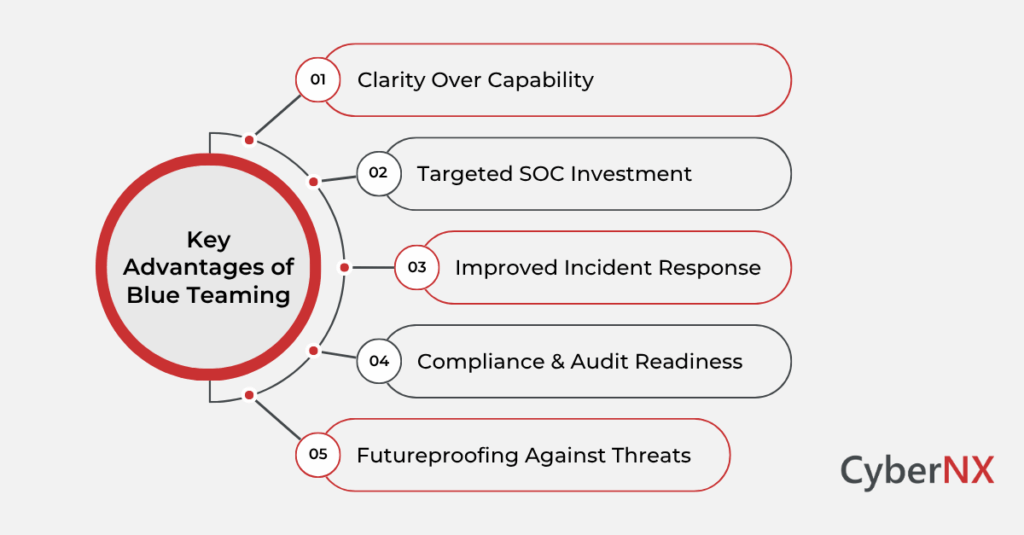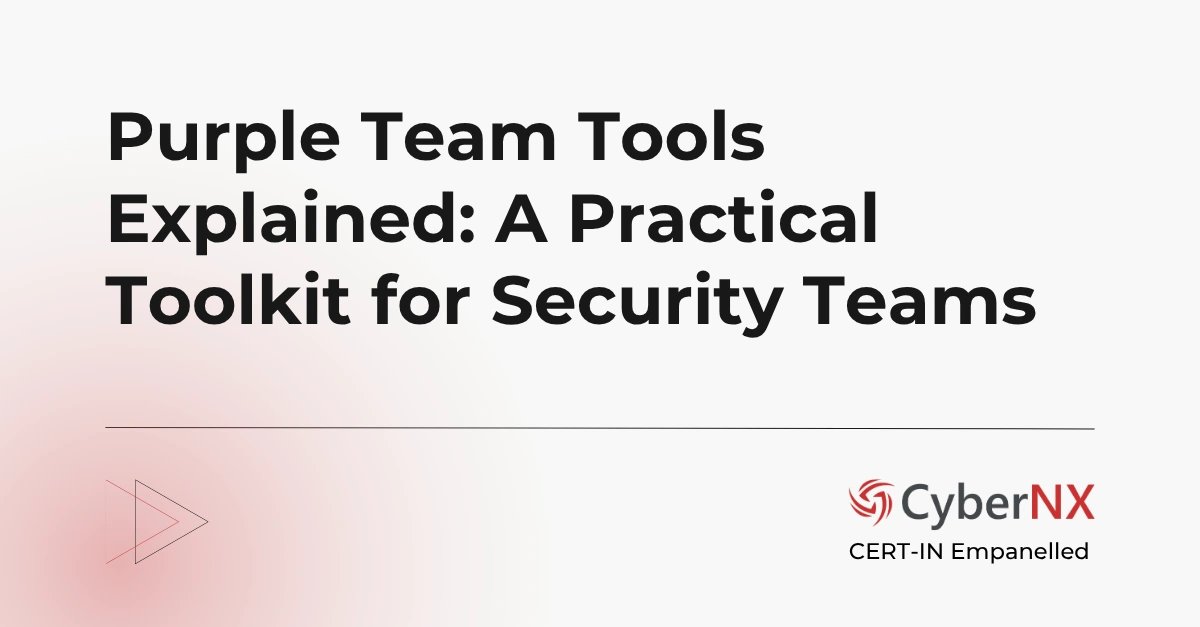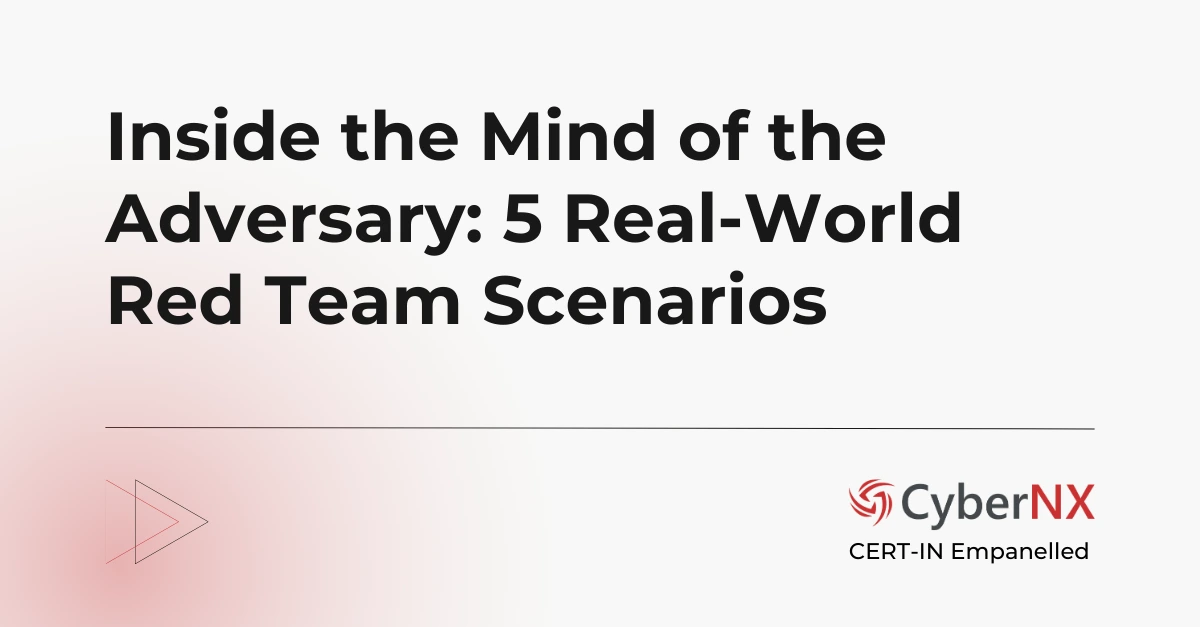Ask any security leader, CISO or CTO about what differentiates resilient organizations from breached ones, and you will hear a single answer: complete visibility of the entire IT environment. But this visibility comes only through persistent defence. That’s where blue teaming comes in.
Blue teaming, according to experts, is arguably the most important, effective and valuable cybersecurity exercise any organization could invest in. The continuous, behind-the-scenes security work turns organization proactive.
It is often observed that offensive security tactics like red teaming steal the limelight and remain in conversations. However, blue teaming deserves your equal attention as it holds your defence every day and builds the muscle memory to withstand modern threats.
This guide takes you deep into the world of blue teaming: what it is, who they are, how they operate, and why your business depends on them more than ever.
What is Blue Teaming in Cybersecurity?
Blue teaming can be understood as a cybersecurity exercise or practice. It is an important part of a structured defensive strategy an organization implements. The goal is to identify, assess and respond to cybersecurity threats revolving around your IT system. This is especially focused on threats that are evolving and modern.
The blue teaming process chiefly involves continuous monitoring, incident response, system hardening and threat detection. It ensures the confidentiality, integrity and availability of enterprise assets in the face of cyberattacks.
Blue teaming, which is often ongoing, enables organizations to build durable security capabilities. This achieved through vigilance, adaptability and data-driven defence. And this strategy evolves alongside threats.
What is a Blue Team in Cybersecurity?
A blue team in cybersecurity consist of cybersecurity professionals: analysts, engineers, threat hunters and incident responders. This efficient team is responsible for proper functioning of IT defences against every kind of threat. Plus, they anticipate and neutralize them before any damage could occur.
Their mission also involves working with red team to detect threats early, respond effectively and strengthen the organization’s security posture. Now blue team in cybersecurity can be internal or in-house security team or a part of Security Operations Centers (SOCs). Also, they can operate as an independent unit to review defence focused on safeguarding endpoints, networks, cloud assets and users.
As for technicalities, a blue team monitors traffic, performs log analysis and hardens endpoints. Plus, they hunt for threats and build defences that learn from every attack. As you can see, from identifying new vulnerabilities to enforcing zero-trust policies, blue teams are on the frontline 24/7.
Goals of a Blue Team in Cybersecurity
The goals of a blue team can be broken down into five key areas:
- Preventive Defence: Strengthening systems and configurations to reduce the attack surface.
- Threat Detection: Identifying abnormal activity through logs, behavioural analytics, and security tooling.
- Incident Response: Acting swiftly when breaches occur – containing, analysing, and remediating.
- Resilience Building: Continuously refining and adapting defences based on threat intelligence.
- Security Awareness: Elevating the human firewall by training employees and reducing social engineering risk.
In essence, a blue team in cybersecurity ensures business continuity by preventing disruption from internal and external threats.
5 Benefits of Blue Teaming – Why Businesses Need Blue Teaming?
Blue teaming is no longer optional – it’s a core pillar of modern cybersecurity. As threat actors become more sophisticated, reactive defence simply doesn’t cut it. Blue teaming enables businesses to evolve beyond detection and response. Continuous risk management and resilience become the norm with blue teaming.
Here are five strategic reasons businesses need blue teaming:
1. Continuous Protection
Blue teams operate 24/7, offering always-on protection. This real-time vigilance ensures threats are detected and stopped before escalating into costly breaches.
2. Operational Resilience
From ransomware containment to patch management, blue teams minimize downtime and ensure systems recover quickly, preserving operational integrity.
3. Regulatory Compliance
With data protection laws like GDPR and HIPAA tightening globally, blue teams help enforce policies, log access, and support audit trails.
4. Reduced Financial Risk
The cost of a data breach can be devastating. Blue teaming reduces this risk by actively minimizing vulnerabilities and limiting attack scope.
5. Improved Security Culture
Through internal phishing simulations, employee training, and regular risk communication, blue teams build a security-first mindset across the organization.
Inside the Blue Team: Actions that Shape Security Maturity
Cybersecurity discussion by experts, journalists and technologists revolve more around attack stories. But what defines an organization’s security posture is the unseen work done by the blue team. They play a strategically important role in reducing breach risk, enable compliance and empower business continuity.
Here’s a breakdown of what blue teams bring to the table, mapped to their value for executive decision-makers:
1. DNS and Email Trustworthiness
Blue teams actively audit and enforce domain-level controls that prevent attackers from exploiting the organization’s identity. This includes verifying DNS records to defend against cache poisoning and domain hijacking.
They also implement and monitor email authentication protocols like SPF, DKIM and DMARC. This is how they help in brand protection. These controls directly reduce impersonation attempts on CXOs, finance teams and supply chain contacts, protecting against fraud and reputational damage.
Strategic Value: Reduces likelihood of BEC (Business Email Compromise), the number one attack vector in enterprise data breaches.
2. Network Monitoring and Log Intelligence
Through Security Information and Event Management (SIEM) platforms, blue teams ingest terabytes of log data. The sources include network, firewall activity, endpoint telemetry, identity logs, and stitch them into coherent threat narratives.
What may look like just noise often reveal credential misuse, lateral movement or data exfiltration attempts. The ability to identify a failed login followed by anomalous port scanning is what turns passive logging into proactive detection.
Strategic Value: Enables measurable MTTD (Mean Time to Detect) reductions and early-stage threat interception.
3. Shadow IT and Digital Footprint Mapping
Security perimeter is no longer confined to the firewall. But it extends to every
public-facing API, misconfigured cloud bucket, forgotten subdomain and third-party vendor dependency.
Blue teams use commercial as well as open-source tools and attack surface management platforms to assess external exposure in real time. By identifying unauthorized assets like a staging server left online or an expired TLS certificate, they shut the door on cyber attackers before they could even knock.
Strategic Value: Prevents reputational and compliance fallout from overlooked public assets and reduces zero-day exposure risk.
4. EDR for Behavioural Anomalies
Endpoints are primary targets, the ground zero kind of thing for most modern attacks. Examples include phishing payloads, fileless malware and privilege escalation. Blue teams use Endpoint Detection and Response (EDR) platforms to detect threats and to understand attacker intent.
Here is an example: Identifying encoded PowerShell scripts running under trusted processes like explorer.exe triggers automatic isolation policies. But behavioural heuristics spot polymorphic malware that signature-based tools miss.
Strategic Value: Achieves fast lateral movement containment and ensures attacker dwell time is minimized to minutes, not days.
5. Hypothesis-Driven Threat Hunting
Threat hunting is more of a mindset. Blue teams regularly design and test hypotheses. This could be like “Could a compromised employee account be accessing SharePoint during off-hours?” or “Is there beaconing to known C2 infrastructure from dev machines?”
Leveraging behaviour analytics, threat intelligence and custom YARA rules, they look for signs of compromise that have not triggered any alerts. This human-led exploration discovers silent footholds and stealthy cyber attackers operating below the security radar.
Strategic Value: Detects advanced persistent threats (APTs) before impact and validates that current security controls are working as intended.
6. Simulated Attacks and Blue Team Response Drills
Blue teams do more than just observe. They engage in real time detection, escalation, response and post-mortem of an incident. These exercises are not to be considered as tests. Instead, these are operational rehearsals that stress-test people, processes and technology in the system.
Also, blue teams use simulations to identify automation gaps, improve incident runbooks and train junior analysts in live conditions.
Strategic Value: Provides executive assurance of readiness and exposes real-world weaknesses without any real consequences.
Skill Sets Required in a Blue Team
There are certain skill sets a successful and proficient blue team needs to possess. This includes technical proficiency plus strategic thinking. Some of the core skill sets are:
- Network and Systems Expertise: A thorough understanding of TCP/IP, DNS, firewalls, VPNs and operating systems like Windows and Linux.
- Log Analysis & SIEM Proficiency: Should have good grasp of SIEM too and the ability to investigate logs from multiple, different sources. Plus, derive meaningful threat insights.
- Scripting & Automation: Skills in Python, PowerShell, or Bash to automate tasks and analyse large datasets.
- Incident Handling: Familiarity with playbooks, triage processes, and forensic tools for memory or disk analysis.
- Threat Intelligence: Consuming and operationalizing IOCs and TTPs (Tactics, Techniques, Procedures) from threat actor reports.
- Soft Skills: Communication, teamwork and composure under pressure situations like a live breach are a bonus.
Roles Inside a Blue Team
We discussed before how a blue team in cybersecurity is composed. In this section, find out what they essentially do:
- Security Analyst: Monitors alerts, investigates incidents, and provides first-line defence. They triage events and escalate as needed.
- Incident Responder: Takes charge during breaches – identifying the attack vector, containing the threat, and supporting recovery efforts.
- Security Engineer: Builds and configures defence tools – firewalls, IDS/IPS systems, endpoint protection, and cloud security integrations.
- Threat Hunter: Their job is to go searching for the issues inside system rather than a problem to come to them. Thus, they identify stealth threats that evade traditional detection methods.
- SOC Manager: A SOC manages oversees the complete security operations, manages team under him or her, develop workflows and ensures KPIs align with the risk management goals.
- Forensics Specialist: Handling post-breach investigation is their task. They are also into analysing compromised systems to understand attacker behaviour and entry points.
Blue Team Tools
Blue teams rely on software or platforms to gain visibility and control across endpoints, networks and cloud environments. These tools include SIEM systems for log correlation, EDR platforms for endpoint behaviour plus monitoring and network traffic analysis. Vulnerability scanners and orchestration tools are also used. Collectively, this toolset enables fast detection, root cause analysis and consistent response.
To know which are top tools in the market, read our blog Top Blue Team Tools.
Blue Team Certifications
Blue team professionals continuously validate and upgrade their skills. This is one of the parameters business organizations can base their vendor decision. The top certifications include:
| CERTIFICATION | FOCUS AREA / DESCRIPTION |
| CompTIA Security+ | Foundation-level understanding of network security, risk management, and security principles. |
| GIAC Security Essentials (GSEC) | Intermediate certification covering cryptography, access control, and defensive mechanisms. |
| Certified SOC Analyst (CSA) | Specialized in alert triaging, incident monitoring, and SOC-based threat response. |
| GIAC Certified Incident Handler (GCIH) | Emphasizes incident response, malware handling, threat containment, and attack lifecycle. |
| Certified Cyber Defender (Blue Team Level 1 & 2) | Practical, hands-on blue team training focused on real-world defence scenarios. |
| Certified Threat Intelligence Analyst (CTIA) | Develops skills in threat actor profiling, IOC correlation, and intelligence-driven defence. |
Blue Teaming vs Red Teaming
Blue Teaming vs Red Teaming approach represents the core contrast between defence and offense in cybersecurity. Red teams simulate real-world attacks to uncover vulnerabilities. Blue teams defend systems through monitoring, detection, and response. Together, however, they create a feedback loop that enhances overall organizational resilience.
Here is an easy-to-understand chart explaining different features of blue teaming and red teaming:
| FEATURE | BLUE TEAMING | RED TEAMING |
| Purpose | Defence, detection, and response | Offensive simulations to find gaps |
| Approach | Continuous and proactive | Periodic and adversarial |
| Key Objective | Strengthen security posture | Test organizational resilience |
| Focus Area | Monitoring, EDR, log analysis | Exploits, social engineering, lateral movement |
| Output | Incident reports, threat models | Findings, vulnerabilities, access proofs |
| Tools | SIEM, IDS/IPS, SOAR | Metasploit, Cobalt Strike, Kali Linux |
While red teams attack, blue teams protect. But their true power is unlocked when they collaborate, forming a purple team, where offense and defence learn from each other.
To have detailed understanding of all the security exercises, read our blog Red Team vs Blue Team vs Purple Team.
Conclusion
The blue team is no longer just the reactive part of a cybersecurity strategy. It is a dynamic, proactive force that safeguards everything your business runs on. As attackers grow smarter, the only way to keep up is with a well-trained, well-equipped and well-coordinated blue team.
Businesses that prioritize blue teaming are prepared and build not just firewalls, but a culture of cyber resilience.
If your organization is looking to elevate its defence strategy, now is the time to invest in blue teaming, because real security is being ready for the unknown, future threats.
Contact us to know how we can help your organization to develop a stronger security posture against modern threats.
Blue Teaming FAQs
What’s the difference between a blue team and a SOC?
A SOC (Security Operations Center) is a facility or team that houses security analysts responsible for monitoring and responding to threats. Essentially, a SOC is where the blue team operates. However, blue teaming may extend beyond the SOC, involving roles in engineering, compliance, and forensics across departments or geographies.
How does blue teaming contribute to zero-trust architecture?
Blue teams are key enforcers of zero-trust policies. They monitor identity verification, micro-segmentation, and least privilege access controls. They also continuously validate that no device or user inside the network is inherently trusted. They ensure authentication, authorization, and access policies are applied rigorously and dynamically.
Can blue teaming be outsourced or should it be in-house?
Many organizations use a hybrid model. In-house blue teams provide contextual awareness and faster response. Outsourcing to Managed Security Service Providers (MSSPs) or MDR providers offers scalability and 24/7 coverage. The ideal mix depends on budget, maturity, and internal skill availability.
How do blue teams measure success?
Success is measured through metrics like Mean Time to Detect (MTTD), Mean Time to Respond (MTTR) and number of incidents contained. It also depends on reduction in false positives, compliance audit scores and incident recurrence rates. High-performing teams also conduct regular red team or purple team evaluations to stress-test their readiness.
What’s the biggest myth about blue teams?
That they only respond to incidents. In reality, blue teams are proactive agents of security hygiene, from patching systems and reducing attack surfaces to training employees and simulating phishing attacks. They don’t wait for problems – they actively prevent them.






